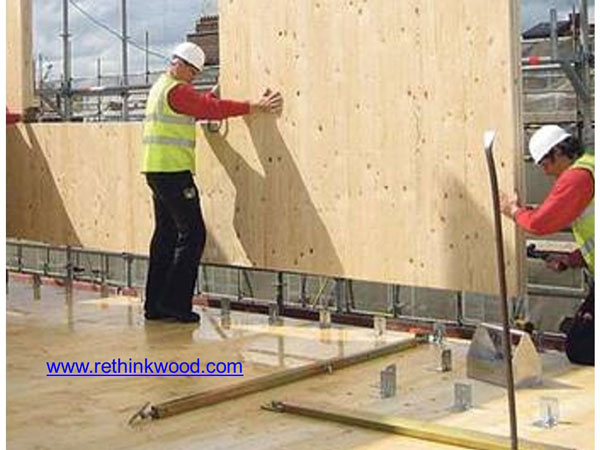
By Gregory Havel
Photos as noted
The use of cross-laminated timber (CLT) was recently incorporated into the 2015 edition of the International Building Code (IBC), with an unprotected fire resistance rating of up to two hours. It is likely to be incorporated into the next edition of National Fire Protection Association (NFPA) 5000, Building Construction and Safety Code.
The IBC places limits on the heights and areas of CLT structures that are similar to those of conventional Type IV (heavy timber) and Type V (wood frame) construction. As a result, the two high-rises that are proposed to be built in Oregon and New York will need variances from the building codes by state and local building officials. The IBC also permits taller buildings with larger floor areas when equipped with automatic fire sprinkler systems.
CLT panels can be used as walls, floor/ceiling assemblies, and roofs. They can be connected to each other; to other manufactured wood products; to structural steel; to concrete; and to masonry. Each combination of materials has several attachment methods, as do the connections between floor and wall, wall and wall, panel to panel, and roof to wall. Some of these methods and connectors are shown with this article.
As this is a relatively new material in the United States, and is not yet in use in southeastern Wisconsin, the photos and illustrations used are from manufacturer and other Web sites, as noted. These photos are for illustrative purposes only, and do not constitute an endorsement of any product or manufacturer.
Connections between CLT panels can use mechanical fasteners or adhesives or both.
- The construction adhesives used are usually a polyurethane paste applied in beads with a hand-operated or powered dispensing gun.
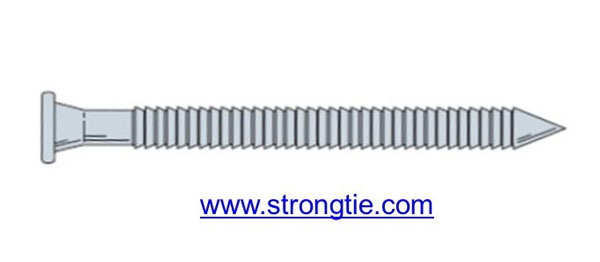
- Photo 1 (above) shows a type of ring-shank nail that can be used to fasten CLT panels together.
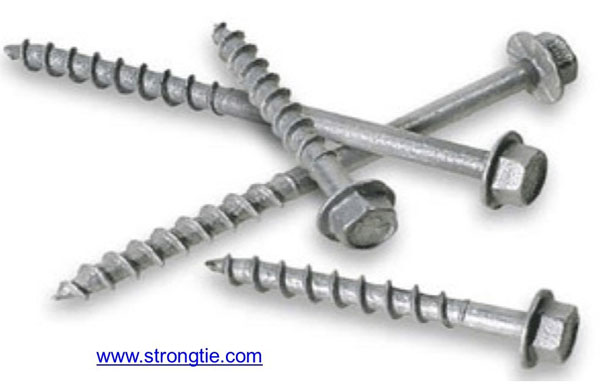
- Photo 2 shows a type of patented screw that can be used to fasten CLT panels together, or to attach plates or angles to the CLT panels.

- Photo 3 shows an edge of a CLT panel that has been milled to receive three wood splines, which will be attached with construction adhesive and screws.
- Half-lap joints are milled on the edges of CLT panels at the factory, and connected in the field with adhesive and screws or nails.
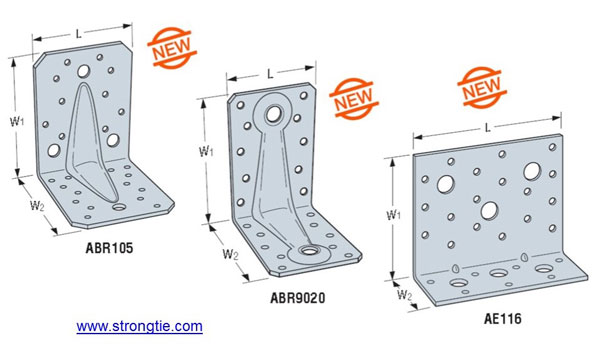
- Photo 4 shows three types of plates and angles that can be used to connect CLT panels to each other, or to concrete or masonry. These will be attached to the CLT panels with screws similar to those shown in Photo 2. These plates and angles may be exposed or concealed. Even if they are exposed after the panels are connected, they will be concealed by interior finishes and exterior cladding.

- Photo 5 shows a CLT wall panel being set with a crane, and which will be connected to the CLT floor with the plates and angles that are already attached to the floor.
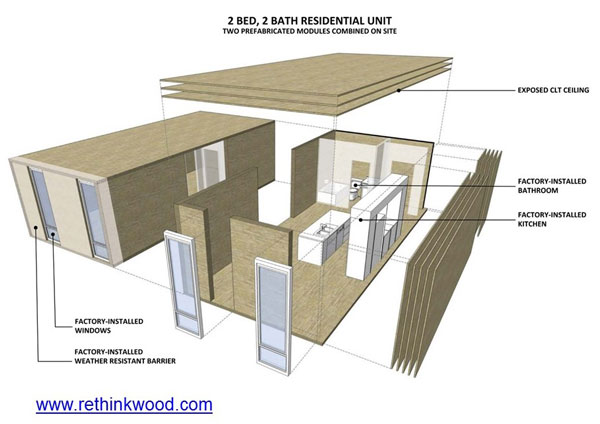
- Photo 6 shows how preassembled CLT modules can be combined together to form single-family and multi-family residential buildings.
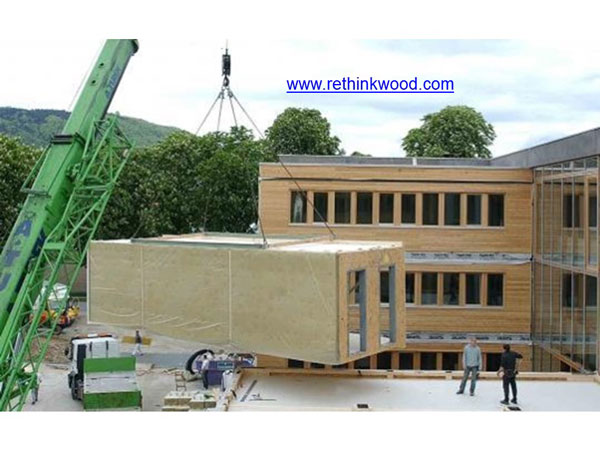
- Photo 7 shows a crane setting another preassembled CLT module during construction of an apartment building.
- Bolts, rods, dowels, and cam-locks are other types of mechanical fasteners that are used to connect CLT panels.
It should be of concern to firefighters that a building of CLT construction will look like any other modern building (or older remodeled building) when it is finished. The CLT and their connections are likely to be concealed on the interior with gypsum drywall board, wood paneling, or other materials in common use in building interiors of all types. They are likely to be concealed on the exterior by insulation and exterior finishes like Exterior Insulation Foam System (EIFS), void spaces for loose-fill insulation and utilities, and noncombustible cladding (metal, cement-board). Unless the building has a preincident plan on file that was prepared either while the building was under construction or from the building plans after it was completed, firefighters will not be aware of the construction materials and methods used in the building; and will not be able to reliably predict the behavior of a fire starting in the building.
For more information on cross-laminated timber, its uses, and its connection methods:
- Search the Internet for “cross laminated timber” or “CLT”;
- Review manufacturer Web sites;
- Check the index of the International Building Code, 2015 edition, for “cross laminated timber” and ‘CLT”;
- Review the CLT Handbook, US Edition, © 2013 by FPInnovations and the Binational Softwood Lumber Council. It is a free download by chapter or in its entirety from http://www.rethinkwood.com/tall-wood-mass-timber
- Read the articles on this subject in the January 2016 issue of Fire Engineering and the July 2013 “Construction Concerns” (links below)
Visit http://www.rethinkwood.com/tall-wood-mass-timber/tall-wood-competition and https://tallwoodbuildingcompetition.org
Download this article as a PDF HERE (202 KB)
RELATED
Cross-Laminated Timber Structures – Building Construction and Firefighting
Construction Concerns: Cross Laminated Timber
Quebec Government Releases Guide on Construction of 12-Story Wood Buildings
Fire Protection Research Foundation Report on Fire Safety Challenges of Tall Wood Buildings
 Gregory Havel is a member of the Town of Burlington (WI) Fire Department; retired deputy chief and training officer; and a 35-year veteran of the fire service. He is a Wisconsin-certified fire instructor II, fire officer II, and fire inspector; an adjunct instructor in fire service programs at Gateway Technical College; and safety director for Scherrer Construction Co., Inc. Havel has a bachelor’s degree from St. Norbert College; has more than 35 years of experience in facilities management and building construction; and has presented classes at FDIC.
Gregory Havel is a member of the Town of Burlington (WI) Fire Department; retired deputy chief and training officer; and a 35-year veteran of the fire service. He is a Wisconsin-certified fire instructor II, fire officer II, and fire inspector; an adjunct instructor in fire service programs at Gateway Technical College; and safety director for Scherrer Construction Co., Inc. Havel has a bachelor’s degree from St. Norbert College; has more than 35 years of experience in facilities management and building construction; and has presented classes at FDIC.
MORE CONSTRUCTION CONCERNS

